Table Of Contents
Best Manual Tile Cutters for All Tiles 2021
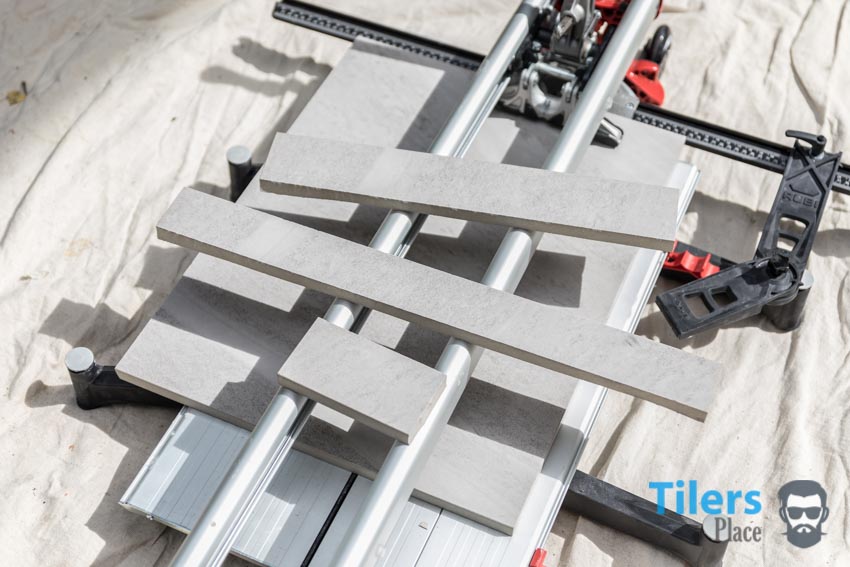
Believe me, it happens. I get these calls a few times every year and every time I inspect the site I see two things: A cheap tile cutter hiding somewhere off the side and a heap of broken tiles next to a few tiles that have been installed.
Don’t be that guy/gal!
My best manual tile cutter guide shall help you select a tile cutter that’s fit for your purposes and will not result in a despair and disappointment.
Our 7 Favorite Manual Tile Cutters

I cut tiles on every single job and know a thing or two about making them break to my requirements. A manual tile cutter is a tilers best friend and I know what to look for while deciding which one will be an asset or a pain in the ass.
Manual Tile Cutter Reviews
The Montolit Masterpiuma 75P3 29” Manual Tile Cutter is a very popular and beloved tile cutter used by tilers all over the world. Hailing from the land of Ferrari and Pizza, you know it’s gonna be special.
Montolit tile cutters all follow the same design principles but vary in sizes to accommodate different size tiles. The 29” Inch 75P3 is easily the most popular as it can accommodate the 24” tile that has been breaking tilers backs for over a decade now. You are likely looking a 24” porcelain tile for your own project or possibly a 12×24” tile. If it’s a large project and your tile is expensive, I highly recommended you purchase the Montolit, then sell if off after the project is done.
Don’t muck around with the cheaper tile cutters in this review as you’ll end up cursing the day you were born.
The Montolit Masterpiuma is at home cutting regular porcelain tile from 8 to 12mm thick and creates beautiful straight cuts with help from the inbuilt lubrication system that makes sure the scoring wheel is always flowing smoothly along the tile. It’s also self-adjusting so you always have the right amount of pressure while scoring, eliminating the risk of breaking tiles prematurely. That’s something my Rubi Magnet did while I was still learning how to use it.
It is fairly cumbersome as the measuring bar doesn’t dissemble so moving it from site to site is more of a concern for professionals. It’s adjustable at least so you can setup multiple cuts of the same length of even do diagonal cuts if the job requires it.
The tile cutter itself is made of die-cast aluminum and nickel-plated steel so weight has been cut down where it can. The steel is required to give the manual tile cutter strength when popping porcelain tile.
Another great feature of the Masterpiuma is the ability to cut glass mosaics and other tricky tile. Simply purchase a Montolit mosaic mat, lay it onto your cutting base and you can effortlessly cut glass tiles cleanly and accurately without the need of a wet cutting tile saw and specialist glass blade. Anyone that has cut glass before will be frothing at the mouth after reading that.
Bottom Line:
This is a professional tool with a price tag that reflects this, but in this game, you get what you pay for. If you want the best way of cutting porcelain tile, without wasting time or tiles – stop reading this tile cutter guide as you have found the best tile cutter for your project.
The Rubi SPEED-N 28” Tile Cutter is a more budget friendly cutter designed for handyman and homeowner use. It lacks some of the more hardcore features of it’s professional brothers but still carries the Rubi Tools quality and design features that others lack in this bracket.
Like the Montolit Masterpiuma, the SPEED-N can cut the popular 24” tile your spouse is so in love with, it’ll also cut ceramic and even glass tiles without too much effort. This is all thanks to it using Rubi’s patented system of scoring blades that are interchangeable and enable the tile cutter to cut through any type of tile. You simply choose the blade that’s required for the job. I generally stick with a 8 or 10mm blade and use it on everything – easy.
Where this tile cutter cuts on price is the foam base and not a spring loaded one like seen on the more expensive models. What it means for you is you’ll need to take more care while breaking thick porcelain tile. Breaks will require more effort from you as well as the tile cutter isn’t absorbing or creating the same amount of pressure as the spring loaded base would. It’s no biggy, it’s just a bit slower is all.
Many other features of the pro tile cutters are included like extendable wings to hold large tiles, and a well-built measuring bar that’ll enable cutting tiles to the same length.
Bottom line:
Most of the features of a professional tile cutter without the price tag. The Rubi Speed-N is a more budget friendly option for those not ready to fork out for professional tools. It incorporates many of the beloved features that Tilers love but cuts costs where it can with a float cutting base and lack of diagonal cutting ability.
If you have a straight forward job, I’d opt for this tile cutter and leave any diagonal cuts to a hand held tile saw or grinder which you’ll be using anyway for detailed cuts.
A quick fact for you, these three brands: Montolit, Rubi and Sigma are the best tile cutter brands out there and the only 3 that produce professional tile cutters. All other brands you’ll see on this review and in stores are strictly for DIY and homeowner use, you won’t see professional tilers using them. They simply can’t handle the requirements of daily use and lack the versatility of cutting a different tile every day.
The Sigma 3B4 26” manual tile cutter is another cutter capable of cutting 24” tile and anything smaller. It has a handy measuring bar that rotates 45 degrees in either direction which makes it capable of cutting diagonally up to 18.5”. Like the other 2, it’s made of aluminium and steel for strength.
Sigma believes in their one-size cut’s all scoring wheel which of 12mm. It does this very well but I prefer the versatility of the Rubi as sometimes bigger isn’t always better. Another bizarre aspect of this Sigma model is the reversed push handle, unlike the Montolit where it’s facing the right direction, this Sigma is reversed which makes it hard to see where you are scoring. Some tilers upgrade this handle to a different model whilst others simply reverse it. This technicality should be considered if you plan on using this tile cutter for more than one project.
Bottom Line:
Another pro-level dry tile cutter that should be considered by those needed the very best in quality and versatility. At this price point, the more popular and easy to use Montolit would be my choice however.
I have no idea what Tomecanic even means or what it’s alluding too but they’ve knocked out a tile cutter which is an odd pseudo rip-off of the Sigma design with a convoluted spring loaded breaker bar that’s more complicated than it needs to be.
Right off the bat you can tell it’s not designed for professional use, the finish is more crude and the excess of parts means that when it breaks, it breaks hard and will grind work to an extended halt while you scramble to fix it with your client breathing down your neck.
For DIY use of course, this shouldn’t be an issue as you won’t be facing the same time constraints that a professional would.
Bottom Line:
This tile cutter is a brute. You have heaps of strength and bulk but it’s misguided and it ends running into a brick wall. Great for snapping large amounts of tile but don’t expect the cuts to be the most accurate.
If you don’t feel like playing, I’ll tell you what you’ll find.
Every single review mentions a QEP tile cutter. Why?
Cause they’re extremely cheap, available everywhere and no tile cutter review is actually unique. One content writer copies from another and the name is propagated like that across hundreds of sites. Trust me, I know how these sites work and know you can buy articles written by people that don’t know what tiles are, let alone understand tools that cut them.
It’s come to the point that if you don’t mention a QEP tile cutter in your manual tile cutter review or comparison, your website won’t show up anywhere in Google. Cool right?
Bottom Line:
This review has suddenly become weird and I hate what tool review sites have done to search engines and the miss-information they spit out. Oh if you truly want to know about this tile cutter, read the review for the 35″ model, they’re exactly the same just a different size.
It boasts a fantastic and original name that cleverly alludes to it’s size of 90cm however I’m not sure what the 10 stands for.
The Qep tile cutter follows the rough design principle pioneered by RUBI Tools with the twin chrome-plated rails but then decided to copy Sigma and Montolit with the curved handle and scoring wheel placement. Some would say it’s the best of both worlds, realists who understand the price would say the opposite.
On paper, the QEP 10900Q tile cutter can cut ceramic, porcelain and glass tiles, but please realize that fact is simply not enough.
What you need to know is whether it will cut porcelain or any type of tile reliably and cleanly. Anything can score a tile, but breaking it cleanly along that line is the major factor.
What I have found and countless other souls who spent their money on this tile cutter is that it depends on the tile, especially porcelain. Some porcelain tile will pop cleanly whilst others will simply break however they want to. When that happens, you’ll need to mark out a new tile and try again.
I hope you purchased spares! (Remember, with large tiles, it’s recommended to purchase at least 15% extra then what you require. 10% for smaller tile.)
Hopefully you’re beginning to understand why the first 3 tile cutters mentioned in this review are priced like that. With those 3 you can be sure they’ll cut whatever tile you have, whilst the cheap options are only shooting in the dark and hoping to score.
I’m disgusted that some review sites said this tile cutter is great for contractors as it’s lightweight. If you’re a contractor, don’t fall for this please as you’ll end up spending more on replacing tiles you’ve broken then you spent on this tile cutter.
Also lightweight on a large tile cutter like this is not a virtue to be proud of. These machines have to produce thousands of pounds worth of breaking pressure and lightweight aluminum and sardine can steel won’t give you that. You get flex and broken components.
Bottom line:
If you need to save budget and have the luxury of extra time and tiles, then the QEP 35” tile cutter could be your hero. Do bear in mind not every model is built the same, so keep in mind you may be returning it within the week. It’s a decent tile cutter when it works and can be used on 24” porcelain if it decides to play nice.
Boasting none of the thrills of adjustable cutting depth, seeing where you’re scoring or setting up multiple cuts (essential for brick style layout), this bargain of a tile cutter is ideal for those with lots of time.
Is my sarcasm too much? Sorry.
It costs less than $50 my friend, what’s $50 in today’s overinflated economy anyway. Please don’t expect a lot from this wee toy of a tile cutter.
Yes, it’ll cut ceramic subway tile pretty cleanly and for subway layout that should be enough. You can hide the rough cuts near walls and changes of plane with silicone anyway. Don’t expect to cut anything larger than a subway tile with this though, especially if it’s porcelain.
The tile cutter simply isn’t built strong enough to enable it.
I actually reviewed one of these properly in a standalone review, if you really want to know more about the sucker, you can read it here.
Bottom Line:
Pretty decent for subway tile cutting but not much else. Handy little tile cutter to have around the house but keep in mind this cutter invented the phrase “you get what you pay for.”
You get the added slide stop for multiple cuts, Rubi’s fantastic scoring wheels and generally better build quality in a similar sized package.
Tile Cutter Buying Guide
Here are some of the few basics things you should know when buying a tile cutter for the first time. It can seem daunting but in all honesty, it’s simpler than choosing a tile for your home
Manual Tile Cutter vs Electric – Which Should I Buy?
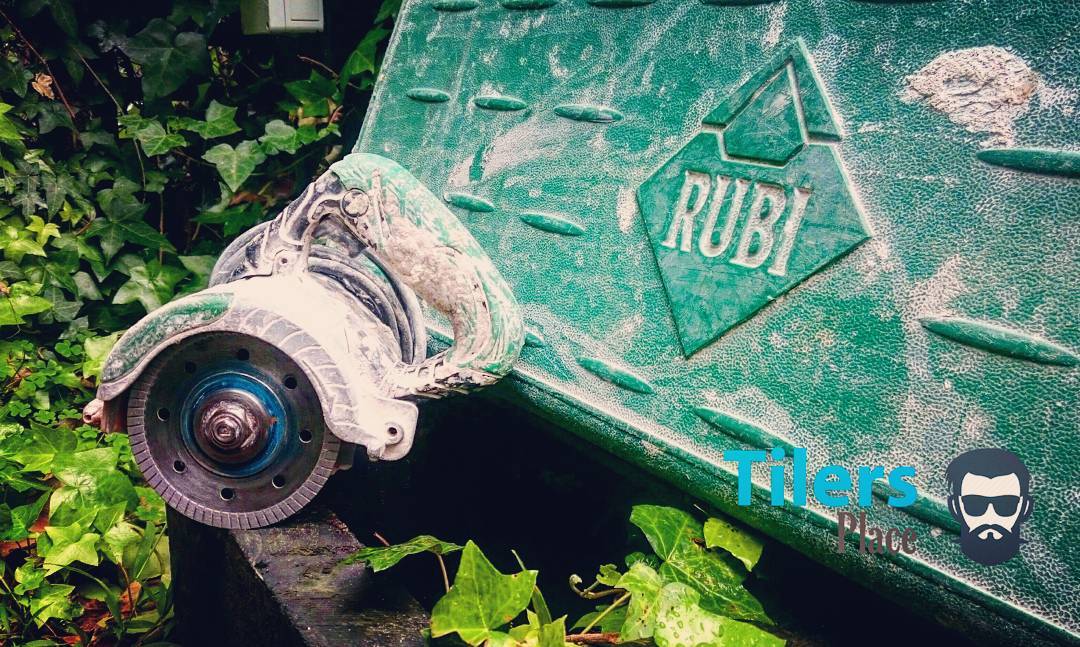
In that case, you have my respect and I hope you know what you’re in for.
An electric tile cutter, commonly referred to as a tile saw or table saw is the only cutting tool that can accurately cut stone. Why?
- Stone is incredibly tough
- More importantly, stone is a naturally occurring material that has “veins” in it. Scoring a line across it isn’t enough for it to cut cleanly. If you try cut stone with a tile cutter, it’ll follow one of it’s natural veins rather than the score you placed. Equalling in lots of wasted materials and no straight cuts.
Side Note:
Most tile projects will have detail cuts like around power outlets, around door frames etc.
In those circumstances, you’ll want a handheld tile saw (my choice and godfather to my children) or a grinder with a diamond blade. So while you are planning out your project, keep an eye out for any detail cuts that will involve more than a straight line, and incorporate a grinder/tile saw into the budget. If you got a grinder already, then all you’ll need is a diamond blade.
Anatomy of a Manual Tile Cutter
• Cutting Base – Usually spring loaded or just a piece of foam rubber in cheaper models. This base moves to absorb some of the tension created by the breaker bar and creates a void that the breaker bar is forcing the tile into from either side of the cut. When it’s not being compressed, it forms a solid base to support the tile while it’s being scored.
• Cutting Wheel – The item that begins the whole process. This metal wheel is usually made out of tungsten carbide and it cuts an even line across the tile, telling it where to break. Not all cutting wheels are made equally and the number of cuts it can do before it gets dull is greatly dependent on the price.
• Guide Rail(s) – These are the shiny parts that run the length of the tile cutter and allow the handle to glide along smoothly. Whilst providing mobility to the handle, they also provide overall strength to the tile cutter.
• Handle – Most tile cutters now come with the breaker bar, handle and scoring wheel built into one unit. This helps free up one hand to hold the tile steady while you work. Rubi’s TS line of tile cutters is a noteable exception with the breaker bar being at the top end of the tile cutter. Regardless of this fact, the TS line of tile cutters is considered one of the best tile cutters for subway tile.
• Measuring Bar – Pretty much every tile cutter comes with an elementary ruler guide on the arms that provide you with handy measurements. More versatile tile cutters will also provide you with a sliding stop that can be set to a required length, enabling you to cut multiple tiles to the same length.
Which Types of Tile Can a Manual Tile Cutter Cut?
Some quarry tile can also be cut with a tile cutter but it greatly depends on the thickness and quality of the quarry tile. Anything harder or natural like stone cannot be cut with a manual tile cutter.
Concrete pavers or outdoor slabs also cannot be cut with a tile cutter. That’s an entirely different beast and shouldn’t be confused with tiles.
Quick Tips On How TO Use A Tile Cutter
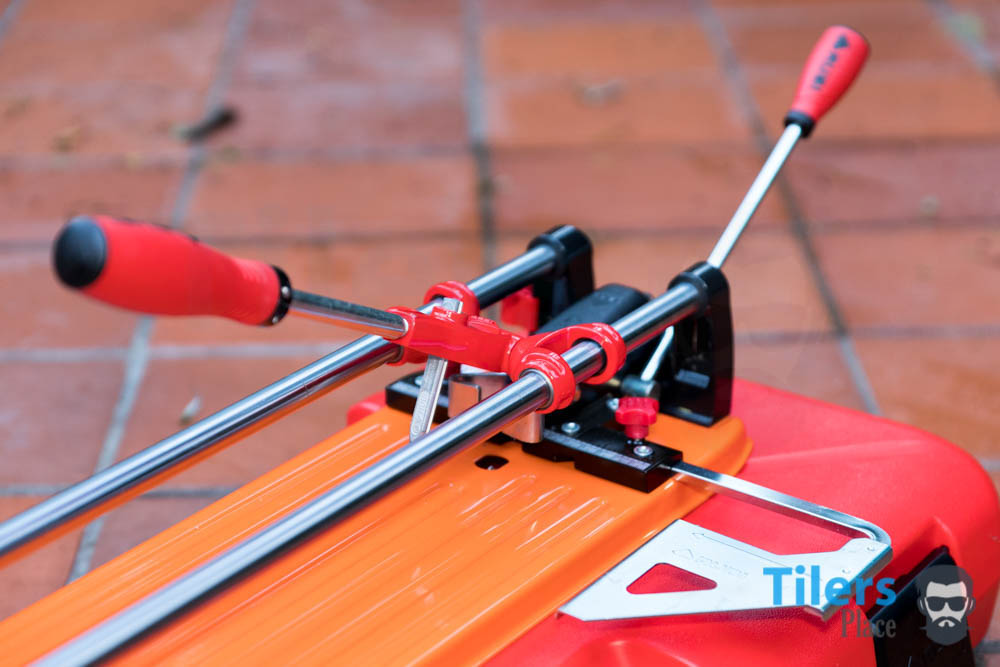
Every tile cutter has a trick to it and you need to figure it out before you begin. Some will only require the slightest of pressure to score properly (like a Rubi TZ) whilst others will need more pressure. Excessive pressure can result in you breaking the tile, not enough will result in a break that went sideways across the tile.
2. Place the tile onto the cutting board with the glazed side facing upwards. Align the tile so that the scoring wheel is directly in the center of your marked line.
3. If you are wanting multiple cuts of the same size, slide your sliding stop up to the tile and fasten it.
4. Pull the handle back towards you and evenly scribe a line across the tiles surface in one stroke. You want to apply even pressure from the top of the cut to the bottom.
5. Drop the breaker bar down and lightly apply pressure to the tile. If the tile dosen’t pop, try sliding the breaker to the bottom of the tile, apply some pressure there and then move it back and try again. I call this “coaxing the tile” and it helps apply even pressure across the tile and promote a cleaner break.
6. If you have jagged edges in your tile, you can clean those up with your grinder.
Conclusion
Previously I only reviewed professional tile cutters but have come to realize that this isn’t very helpful for DIY enthusiasts and homeowners like you that visited my site to try find something new that hasn’t been rehashed everywhere else. Yes, some parts of this review got murky with my grudges but I bet you skipped over those sections anyway.
In regards to tile cutters, they are like many other tools out there. They are made to match specific budgets and their use of materials will directly reflect the quality of the cut.
The top three tile cutters I chose were all from top grade manufacturers and will provide an excellent result, no matter which one is chosen. The Rubi SPEED-N is propably the best out of the budget options (QEP, Tomecanic) whilst the Montolit’s extra features and ergonomic design help win it the top spot out of the pro level tile cutters and the design overall. I also factored in the overwhelming popularity of the Montolit Masterpiuma globally. Literally thousands of tilers swear by this tool for their daily cutting needs and if that isn’t proof that it’s an excellent tile cutter, I don’t know what is.
Thanks for visiting my humble little back water of a website and giving my words a read, it means a lot that you wanted to read my unique albeit testy words, over countless other sites that are very professional but provide little in new information.
Happy cutting and all the best for your project.















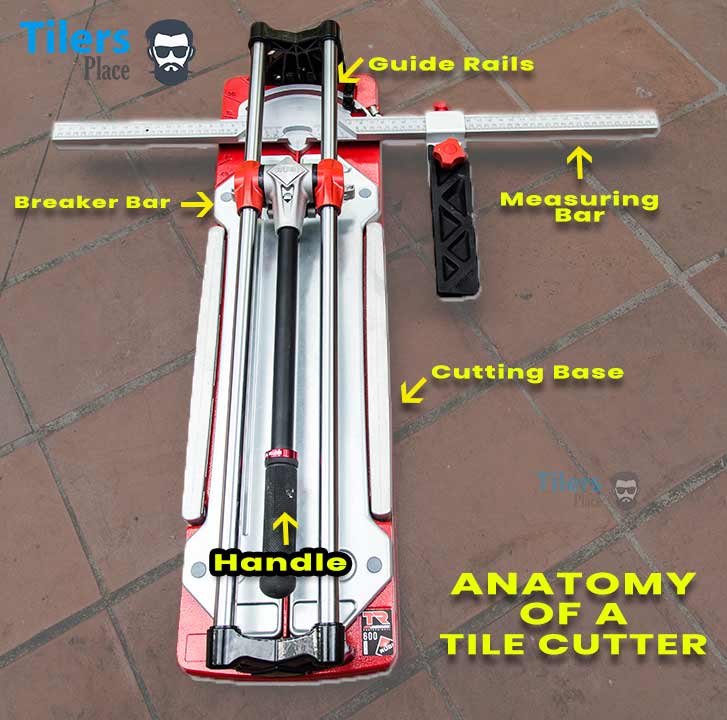
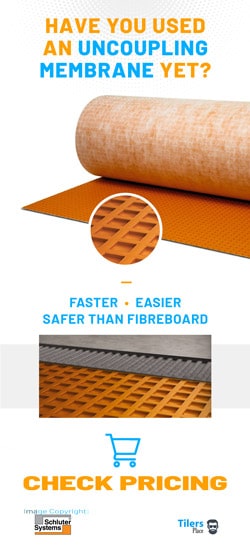


Hey Carl, great review! I stumbled upon it and gave it a read out of pure curiosity as the banner was pretty eye catching. Before I knew it I had read the whole thing!
I have a sneaking suspicion I have actually purchased a “shiny junk” (great name for it btw) last month and I wish I hadn’t. I’d get this Rubi you reviewed but it looks a bit too big for most of my jobs. I work with a company that remodels kitchens and most of the tiles we use are small subway tiles. Do you have any recommendations? I’m thinking even the TX-700 would be too big but I really want the features of it. I might be asking too much haha.
Hi Ricky, thanks for dropping by and leaving a comment.
I feel your pain if you purchased one of those sub-par cutters, I hope it didn’t ruin too much tiles for you!
Yes the TX series is all on the larger size so using them for your application would be overkill and an unnecessary expense. Save your money for some brews at the end of the week or take your lady out to dinner.
For your use I would recommend a cutter like this Rubi TS-40
While you won’t get the movable breaker bar with this manual tile cutter it won’t be necessary since the tiles you will be cutting will be much smaller and thinner.
You also get the dual rail system which ensures accuracy for years and the replaceable scoring wheels.
I have been using one of these for many years for any smaller tile jobs and it hasn’t let me down. My current one is over 4 years old and still as accurate as the day it came out of the box 🙂
Lastly it will cut tiles up to 17inches (40cm). So if you setup your tiles for straight or diagonal cuts, it will be able to cut them easy.
Hope that answers your question Ricky! If you end up getting one lemme know! I’d be interested to hear how you get on.
Regards,
Carl.
For over ten years I have considered myself a Sigma man. I had 4 of their cutters in that time and I admit I was stubborn in my thinking that they were the best. What always bugged me was how they chipped off pieces from thicker tiles and sometimes it was darn near impossible to break a tile.
This review opened my eyes Carl, I had a similar experience to you where my Sigma cutter broke a couple tiles and I had enough. You know what I did? I just purchased the TX-900-N. Only had it for a few days but so far holy hell was a stupid fool for not trying Rubi sooner! It’s a revelation for me. The way it breaks tile with so little effort and more importantly it don’t chip my tile! I can’t believe it. It’s heavier than my Sigma in similar size but I don’t care. I think I’m in love, I won’t be needin to setup my wetsaw so often now too. Thanks for the review Carl, I hope others will see the light like I have.
Hey Chris,
Welcome to the Rubi club! Haha no in all honesty I am very happy my advice and review helped steer a fellow professional to a good decision. I don’t say anything that I haven’t experienced over the decades in our great industry nonetheless everyones view point varies.
I know exactly where you are coming from with the Sigma tile cutter having difficulty breaking bigger tile. I mentioned it above, it’s breaker bar is simply not cut out for it. Excuse the pun although it’s fully intended.
I hope you enjoy your TX-900N as much as I do, I’m sure it won’t let you down!
Be sure to show your buddies my review if they give you flak for choosing a Rubi, your friend Carl will show them the light 😉
Tough luck on loosing that contract Carl, I’ve had it happen to me over stupid crap like that and it really burns. This review came at a good time for me as my Montolit started acting up. The oiling system broke long ago and now it’s beginning to cut crooked. I’ve had a small Rubi for the smaller stuff so I might add his bigger brother to the crew. If the weight’s the only drawback over other systems I can adapt.
Thanks Paul,
Yeah it definitely added a dent to my pride but I deserved it. There’s a reason those QEP manual Tile Cutters go for a fifth the price of a Rubi tile cutter. Seriously that hundred bucks is better spent on a few Rubi scoring blades and some flowers for the wife.
Yup that oiling system is a bit fickle like that. I always hated refilling the damn thing during the work day. A quick burst of WD-40 should be enough to keep the scoring wheel turning.
Let me know if you end up getting a Rubi TX, I am interested to hear your results.
Hi Carl I enjoyed reading your review. I have a small landscaping business and we lay quite a lot of Marshalls Symphony vitrified paving. The paving is 20mm thick Would a ruby dry cutter do the job or would you reccomend a wet saw? I never cut anything thinner than 20mm so I dont want to spend £400 on a cutter that is constantly working at its limit when I maybe should just pay£1000.00 for a ruby wet saw. Any comments would be helpfull. ps I use a stihl saw with a waterfed ceramic blade at the moment
Hi Steve,
thank you for the interesting comment! I had some fun researching and learning about the vitrified paving system before replying to you.
So it appears that the pavers are a lot like thick outdoor tiles. Especially since they are vitrified which makes cutting them very similar to tiles i.e they are tough as hell!
You are correct in thinking about the manual tile cutter. For one, the TX is not ideally suited for cutting tiles (or pavers) up to 20mm in thickness, that’s left up to Rubi’s latest system of manual tile cutters: The TZ Series. They can confidently cut tiles up to 20mm in thickness without issue but note when I say tiles. I’m not entirely confident in recommending such a manual tile cutter as I have never cut vitrified pavers with one, it could end up not working at all!
So yes, in this instance I’d say a Rubi Wet Saw with a diamond blade would be your best option for cutting these pavers. You’ll get beautiful clean cuts and the water system with provide plenty of lubrication and help keep your blade cool.
You could still try out the Rubi TZ however, maybe a tile store in your area has one you can rent or atleast allow you to use it once to see how it cuts your pavers. Cause if it did indeed work, you’d be able to score and snap those pavers in seconds, in comparison to cutting one paver for over a minute each time with a wet saw. Keep it in mind, but for now I’d say your best bet is a wet saw.
Hope that helps, appreciate you dropping by!
and here this old tile setter was thinking the only tile cutter was a tile saw! didnt know manual tile cutters like these were around. think i need to try me one next time im at the tile store and get to cutting some tiles. if they cut porcelain tiles as good as you say, i am definitely buying me a manual tile cutter for sure!
Hey Sam,
Haha I’m glad you learned something new about manual tile cutters today! They certainly cut tiles really well and help take the load off the tile saw. No more need to do all straight tile cuts on the saw anymore. Definitely check out one of the manual tile cutters I recommend in the review, you won’t be sorry!
i got both the monti tile cutter and a rubi tile cutter and i equally love both. both manual tile cutters work for different tiles hence why i use both. the crap thing is how different tiles are, we really are dancing with catastrophe with every tiling job we take on. one day the tiles cut great, the next they break like glass. It’s great to see a tile cutter review where different tile cutters are talked about and no reccomendation of cheap junk cutters like those qeps.